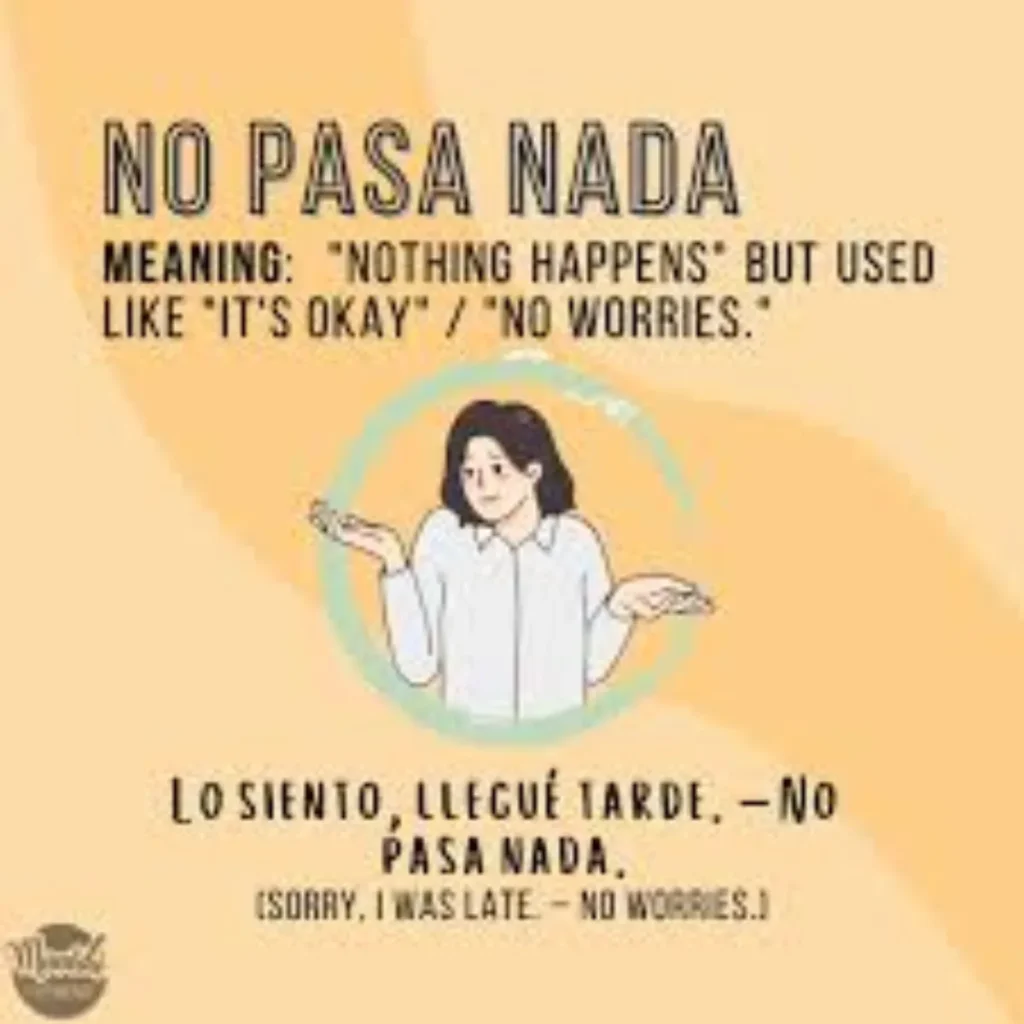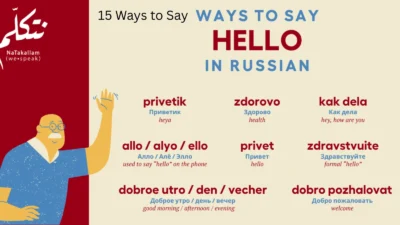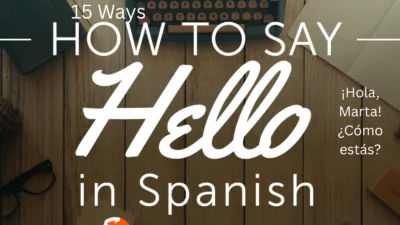Learning 15 ways to say you’re welcome in Spanish will help you respond naturally and politely in everyday conversations. If you’re thanking a friend, speaking in a formal setting, or chatting casually, knowing the right way to say you’re welcome in Spanish shows respect and cultural understanding. Spanish offers several variations for this simple but important phrase, each with its own tone and context.
In this guide, you’ll discover 15 ways to say you’re welcome in Spanish, along with examples so you can choose the right expression for any situation. By mastering these phrases, you’ll sound more fluent and confident when interacting with native speakers. Plus, you’ll be able to respond in a way that feels warm, genuine, and culturally appropriate.
You’re welcome in Spanish
Here are 15 ways to say you’re welcome in Spanish, complete with conversation examples and a bit of history behind each expression.
1. De nada – “It’s nothing”
Origin:
Literally means “of nothing.” It’s the most common and universal way to say “you’re welcome” in Spanish.
Example:
👤 User A: Gracias por tu ayuda.
👤 User B: De nada.
Use: Neutral, polite, and appropriate in almost all situations across the Spanish-speaking world.
2. No hay de qué – “There’s nothing to thank for”

Origin:
A slightly more formal or traditional expression, often used in Spain and Latin America.
Example:
👤 User A: Muchas gracias por prestarme el libro.
👤 User B: No hay de qué.
Use: Polite and modest; used in formal or respectful settings.
3. Con gusto – “With pleasure”
Origin:
Common in many Latin American countries, especially in Colombia and Mexico. Reflects genuine willingness.
Example:
👤 User A: Gracias por acompañarme.
👤 User B: Con gusto.
Use: Warm and welcoming; slightly more formal than “de nada.”
4. Por nada – “For nothing”
Origin:
A variation of “de nada,” more commonly used in Argentina and other parts of South America.
Example:
👤 User A: Gracias por el café.
👤 User B: Por nada.
Use: Casual and friendly, with a regional touch.
5. A ti / A usted – “To you”
Origin:
Used to return the appreciation, like saying “no, thank YOU” in English.
Example:
👤 User A: Gracias por venir.
👤 User B: A ti.
Use: Informal (“a ti”) or formal (“a usted”); commonly used in reciprocal exchanges.
6. Es un placer – “It’s a pleasure”

Origin:
Used in both formal conversations and customer service, this phrase conveys courteous professionalism.
Example:
👤 User A: Gracias por todo.
👤 User B: Es un placer.
Use: Formal and respectful; often used in business or hospitality.
7. Para eso estamos – “That’s what we’re here for”
Origin:
Often heard in Latin American countries, especially in casual group settings or when offering help.
Example:
👤 User A: Gracias por explicarme.
👤 User B: Para eso estamos.
Use: Informal and supportive; emphasizes community and availability.
8. Cuando quieras – “Whenever you want”
Origin:
Literally meaning “whenever you want,” it’s a friendly way to show that your help is always available.
Example:
👤 User A: Gracias por el favor.
👤 User B: Cuando quieras.
Use: Friendly and informal.
9. No hay problema – “No problem”

Origin:
Borrowed in part from English influence, this phrase is widely used across the Spanish-speaking world.
Example:
👤 User A: Perdón, ¿puedes ayudarme?
👤 User B: Claro, no hay problema.
Use: Very casual, like “no worries” in English.
10. Fue un placer – “It was a pleasure”
Origin:
A more personal version of “es un placer,” often used when ending an encounter.
Example:
👤 User A: Gracias por la cena.
👤 User B: Fue un placer.
Use: Formal or warm; often used at the end of meetings, dinners, or favors.
11. Con mucho gusto – “With great pleasure”
Origin:
A variation of “con gusto,” especially common in Central America.
Example:
👤 User A: Gracias por su ayuda, señor.
👤 User B: Con mucho gusto.
Use: Formal, polite, and cheerful.
12. Es lo menos que podía hacer – “It’s the least I could do”
Origin:
A humble phrase that downplays your effort, used to show kindness without expecting thanks.
Example:
👤 User A: ¡Te debo una enorme!
👤 User B: Es lo menos que podía hacer.
Use: Gracious and modest; best among friends or when doing someone a big favor.
13. No fue nada – “It was nothing”
Origin:
Similar to “de nada,” but more direct and casual. Common in Mexico and urban areas.
Example:
👤 User A: Te agradezco mucho.
👤 User B: No fue nada.
Use: Informal and kind.
14. A la orden – “At your service”
Origin:
Heard often in Colombia and Venezuela, especially in customer service or public settings.
Example:
👤 User A: Gracias por atenderme tan rápido.
👤 User B: A la orden.
Use: Respectful and service-oriented.
15. No te preocupes – “Don’t worry about it”
Origin:
Used when someone thanks you while feeling like they’ve inconvenienced you.
Example:
👤 User A: Gracias, siento haberte molestado.
👤 User B: No te preocupes.
Use: Friendly, reassuring, and empathetic.
FAQs
1. What is the most common way to say you’re welcome in Spanish?
The most common and polite way is “De nada,” which literally means “of nothing.”
2. Are there other ways to say you’re welcome in Spanish?
Yes! You can also say “No hay de qué” (no problem), “Con gusto” (with pleasure), or “Por nada” (it’s nothing).
3. Is “De nada” formal or informal?
“De nada” works in both formal and informal situations—it’s safe to use anytime.
4. How do you say you’re welcome to a friend?
You can say “No hay problema” or “Con gusto,” which sound friendly and casual.
5. What can I say instead of “De nada” in polite settings?
Try “Es un placer” (it’s a pleasure) or “A la orden” (at your service), especially in Latin American countries.
6. How do you say you’re welcome in Mexican Spanish?
Mexicans commonly use “De nada,” but also “Con gusto” or “Para servirte” (to serve you) for a warmer tone.
7. How do you reply to “Gracias” in Spanish?
You can respond with “De nada,” “Con gusto,” or “No hay de qué.” All mean “you’re welcome.”
8. Is it rude to not say you’re welcome in Spanish?
Not rude, but saying “De nada” shows good manners and appreciation—it’s always nice to say it!
9. Can I use “Bienvenido” to mean you’re welcome?
No, “Bienvenido” means “welcome” as in greeting someone (e.g., “Welcome to Spain!”), not as a reply to “thank you.”
10. How can I practice saying you’re welcome in Spanish?
Whenever someone says “Gracias,” try replying with different phrases like “De nada,” “Con gusto,” or “No hay problema.” Practice makes it natural!
Conclusion:
Mastering 15 ways to say you’re welcome in Spanish will help you reply with warmth, confidence, and cultural awareness in any situation. If you’re speaking casually with friends or formally with strangers, choosing the right phrase shows that you understand the nuances of Spanish communication.
By practicing these expressions, you’ll not only improve your fluency but also create a more positive connection with native speakers. Remember — a simple you’re welcome in Spanish, said with sincerity, can make your interactions more friendly and authentic.



